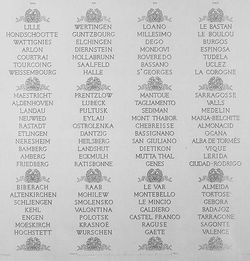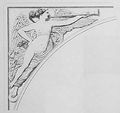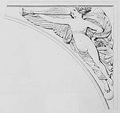Arc de Triomphe


The Arc de Triomphe is a monument in Paris that stands in the centre of the Place Charles de Gaulle, (also known as the Place de l'Étoile), at the western end of the Champs-Élysées.[1] Officially, it is the Arc de Triomphe de l'Étoile, as the smaller Arc de Triomphe du Carrousel exists nearby. The triumphal arch honours those who fought for France, particularly during the Napoleonic Wars. On the inside and the top of the arc there are all of the names of generals and wars fought. Underneath is the tomb of the unknown soldier from World War I.
The Arc is the linchpin of the historic axis (Axe historique) — a sequence of monuments and grand thoroughfares on a route which goes from the courtyard of the Louvre Palace, to the Arche de la Défense. The monument was designed by Jean Chalgrin in 1806, and its iconographic program pitted heroically nude French youths against bearded Germanic warriors in chain mail. It set the tone for public monuments, with triumphant patriotic messages, until World War I.
The monument stands 50 m (160 ft) in height, 45 m (148 ft) wide and 22 m (72 ft) deep. The large vault is -29.19 m (−95.8 ft) high and 14.62 m (48.0 ft) wide. The small vault is 18.68 m (61.3 ft) high and 8.44 m (27.7 ft) wide. It is the second largest triumphal arch in existence.[2] Its design was inspired by the Roman Arch of Titus. The Arc de Triomphe is so colossal that three weeks after the Paris victory parade in 1919, marking the end of hostilities in World War I, Charles Godefroy flew his Nieuport biplane through it, with the event captured on newsreel.[3][4][5]
Contents |
History



It is located on the right bank of the Seine River. It forms the backdrop for an impressive urban ensemble in Paris. The monument surmounts the hill of Chaillot at the center of a pentagon-shaped configuration of radiating avenues. It was commissioned in 1806 after the victory at Austerlitz by Emperor Napoleon at the peak of his fortunes. Laying the foundations alone took two years, and in 1810 when Napoleon entered Paris from the west with his bride Archduchess Marie-Louise of Austria, he had a wooden mock-up of the completed arch constructed. The architect Jean Chalgrin died in 1811, and the work was taken over by Jean-Nicolas Huyot. During the Bourbon Restoration, construction was halted and it would not be completed until the reign of King Louis-Philippe, in 1833–36 when the architects on site were Goust, then Huyot, under the direction of Héricart de Thury. Napoleon's body passed under it on 15 December 1840 on its way to its second and final resting place at the Invalides.[6] The body of Victor Hugo was exposed under the Arch during the night of the 22 May 1885, prior to burial in the Panthéon.
The sword carried by the Republic in the Marseillaise relief broke off on the day, it is said, that the Battle of Verdun began in 1916. The relief was immediately hidden by tarpaulins to conceal the accident and avoid any undesired ominous interpretations.
On August 7, 1919, Charles Godefroy successfully flew his biplane under the Arch [7] . Jean Navarre was the pilot who was tasked to make the flight, but he died on July 10 the same year when he crashed near Villacoublay while training for the flight.
Following its construction, the Arc de Triomphe became the rallying point of French troops parading after successful military campaigns and for the annual Bastille Day Military Parade. Famous victory marches around or under the Arc have included the Germans in 1871, the French in 1919, the Germans in 1940,[8] and the French and Allies in 1944[9] and 1945. A United States postage stamp from 1945 shows the Arc in the background as victorious American troops march down the Champs-Élysées and U.S. airplanes fly overhead.

By the early 1960s, the monument had grown very blackened from coal soot and automobile exhaust, and during 1965–1966, it was thoroughly cleaned through bleaching. By 2007, some darkening was again apparent. The arc is planned to be bleached again in 2011.
In the prolongation of the Avenue des Champs-Élysées, a new Arch was built in 1982, completing the line of monuments that forms the Axe historique running through Paris. With the Arc de triomphe du Carrousel and the Arc de Triomphe de l'Étoile, the Arc de la défense is the third Arch built on the same perspective.
The design

The astylar design is by Jean Chalgrin (1739–1811), in the Neoclassical version of ancient Roman architecture (see, for example, the triumphal Arch of Titus). Major academic sculptors of France are represented in the sculpture of the Arc de Triomphe: Jean-Pierre Cortot; François Rude; Antoine Étex; James Pradier and Philippe Joseph Henri Lemaire. The main sculptures are not integral friezes but are treated as independent trophies applied to the vast ashlar masonry masses, not unlike the gilt-bronze appliqués on Empire furniture. The four sculptural groups at the base of the Arc are The Triumph of 1810 (Cortot), Resistance and Peace (both by Antoine Étex) and the most renowned of them all, Departure of the Volunteers of 1792 commonly called La Marseillaise (François Rude). The face of the allegorical representation of France calling forth her people on this last was used as the belt buckle for the honorary rank of Marshal of France. Since the fall of Napoleon (1815), the sculpture representing Peace is interpreted as commemorating the Peace of 1815.
In the attic above the richly sculptured frieze of soldiers are 30 shields engraved with the names of major Revolutionary and Napoleonic military victories. (The Battle of Fuentes de Onoro is described as a French victory, instead of the tactical draw). The inside walls of the monument list the names of 660 persons, among which 558 French generals of the First French Empire;[10] the names of those who died in battle are underlined. Also inscribed, on the shorter sides of the four supporting columns, are the names of the major victorious battles of the Napoleonic Wars. The battles which took place in the period between the departure of Napoleon from Elba to his final defeat at Waterloo are not included.
There was at the top of the Arc from 1882 to 1886, a monumental sculpture of Alexandre Falguière, "Le triomphe de la Révolution" (the Triumph of the Revolution), a chariot drawn by horses preparing "to crush Anarchy and Despotism", that remained only four years up there before falling in ruins.
Inside the monument opened in Februray 2007, between War and Peace, the new permanent exhibition conceived by the artist Maurice Benayoun and the architect Christophe Girault. The steel and new media installation interrogates the symbolic of the “national monument” questioning the balance of its symbolic message during the last two centuries, oscillating between war and peace.
The Unknown Soldier

Beneath the Arc is the Tomb of the Unknown Soldier from the First World War. Interred here on Armistice Day 1920, it has the first eternal flame lit in Western and Eastern Europe since the Vestal Virgins' fire was extinguished in the year 394. It burns in memory of the dead who were never identified (now in both World Wars). The French model inspired the United Kingdom's tomb of The Unknown Warrior in Westminster Abbey. A ceremony is held there every 11 November on the anniversary of the armistice signed between France and Germany in 1918. It was originally decided on 12 November 1919 to bury the unknown soldier's remains in the Panthéon, but a public letter-writing campaign led to the decision to bury him beneath the Arc de Triomphe. The coffin was put in the chapel on the first floor of the Arc on 10 November 1920, and put in its final resting place on 28 January 1921. The slab on top carries the inscription ICI REPOSE UN SOLDAT FRANÇAIS MORT POUR LA PATRIE 1914–1918 ("Here lies a French soldier who died for the fatherland 1914–1918").
In 1961, President John F. Kennedy and First Lady Jacqueline Kennedy of the United States paid their respects at the Tomb of the Unknown Soldier, accompanied by French President de Gaulle. After the 1963 assassination of President Kennedy, Mrs. Kennedy remembered the eternal flame at the Arc de Triomphe and requested that an eternal flame be placed next to her husband's grave at Arlington National Cemetery in Virginia. President de Gaulle went to Washington to attend the state funeral, and witness Jacqueline Kennedy lighting the eternal flame that was inspired by her visit to France.
Details
- The four main sculptures of the monument are
-
- Le Départ de 1792 (or La Marseillaise), by François Rude
- Le Triomphe de 1810, by Jean-Pierre Cortot
- La Résistance de 1814, by Antoine Étex
- La Paix de 1815, by Antoine Étex
 Le Départ de 1792 |
 Le Triomphe de 1810 |
 La Résistance de 1814 |
 La Paix de 1815 |
- Six reliefs sculpted on the façades of the Arch, representing important moments of the French Revolution and of the Napoleonic era include
-
- Les funérailles du général Marceau (General Marceau's burrial), by P. H. Lamaire (SOUTH façade, right),
- La bataille d'Aboukir (The Battle of Aboukir), by Seurre aîné (SOUTH façade, left),
- La bataille de Jemappes (The Battle of Jemappes), by Carlo Marochetti (EAST façade),
- Le passage du pont d'Arcole (The Battle of Arcole), by J. J. Feuchère (NORTH façade, right),
- La prise d'Alexandrie, (The Fall of Alexandria), by J. E. Chaponnière (NORTH façade, left),
- La bataille d'Austerlitz (The Battle of Austerlitz), by J. F. T. Gechter (WEST façade),
 Les funérailles du général Marceau, 20 september 1796 |
 La bataille d'Aboukir, 25 jully 1799 |
La bataille de Jemmappes, 6 november 1792 |
 Le passage du pont d'Arcole, 15 november 1796 |
 La prise d'Alexandrie, 3 jully 1798 |
La bataille d'Austerlitz, 2 december 1805 |
- Some great battles of the French Revolutionary and Napoleonic Wars are engraved on the attic, including

- A list of French victories are engraved under the great arches in the inside façades of the monument.

- On the inside façades of the small arches are engraved the names of the military leaders of the French Revolution and Empire. The name of the personnalities who died on the battlefield are underlined.
 NORTH pillar |
 SOUTH pillar |
 EAST pillar |
 WEST pillar |
- The great arcades are decorated by allegorical figures representing characters of the Roman mythology (by J. Pradier).
 |
 |
 |
 |
Access
Pedestrian access to the Arc de Triomphe is via an underpass, visitors are not permitted to cross by road which has a heavy police presence. The Arc has one lift (elevator), to the level underneath the exterior observation level. Visitors can either climb 284 steps to reach the top (or attic) of the Arc which contains information and large models of the Arc and also contains a gift shop. Visitors can also take the lift and walk up 46 steps.[11] From the top there is a panoramic view of Paris, of the twelve major avenues leading to the Place de l'Étoile and of the exceptionally busy roundabout in which the Arc stands. The Arc de Triomphe is accessible by the RER and Métro at the Charles de Gaulle—Etoile stop.

See also
- Names inscribed under the Arc de Triomphe
- Bastille Day Military Parade
- Galerie des Batailles
References
- ↑ The "Star" is formed by the radiating avenues.
- ↑ North Korea built a slightly larger Arch of Triumph in 1982 for the 70th birthday of Kim Il-Sung.
- ↑ Melville Wallace, La vie d'un pilote de chasse en 1914–1918, 1978. The film clip is included in The History Channel's Four Years of Thunder.
- ↑ Film of the first flight through the Arc de Triomphe
- ↑ Photograph of the first flight through the Arc
- ↑ Hôtel des Invalides website
- ↑ http://www.histoire-image.org/site/oeuvre/analyse.php?i=260&d=441
- ↑ Image of Nazi parade
- ↑ Image of Liberation of Paris parade
- ↑ Among the generals are at least two foreign generals, Francisco de Miranda and Nicolas Luckner.
- ↑ The elevator is mainly reserved for the handicapped or those unable to walk the stairs.
External links
- Inscriptions on the Arc de Triomphe
- The names of 660 persons inscribed on the Arc de Triomphe
- Clarification of history of Arc de Triomphe
- the permanent exhibition inside the Arc de Triomphe
|
|||||||